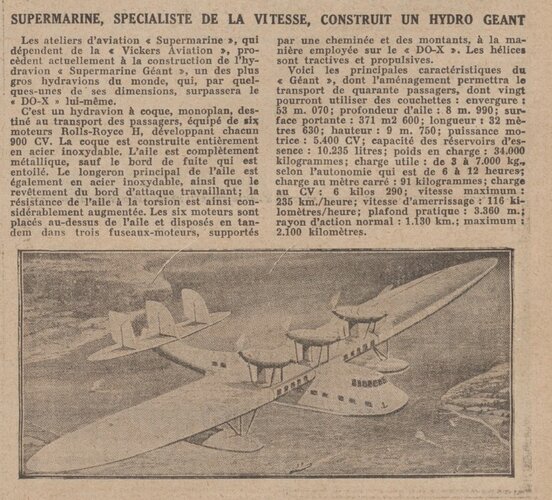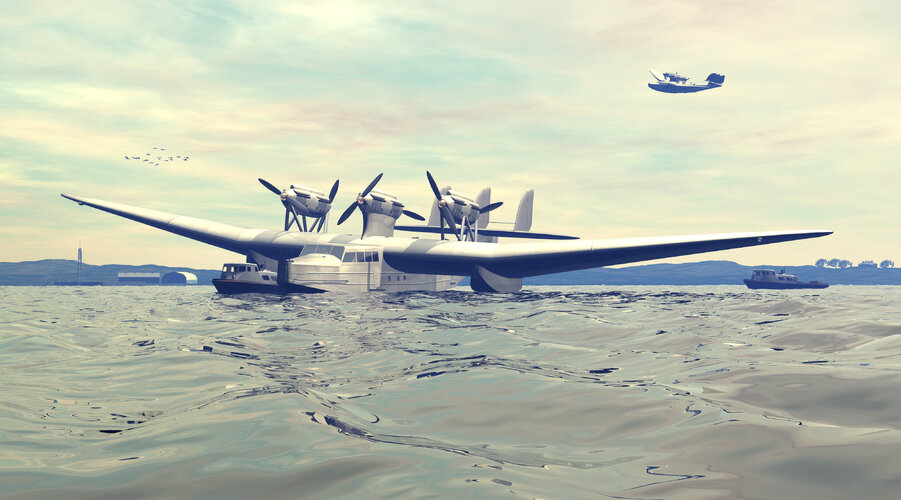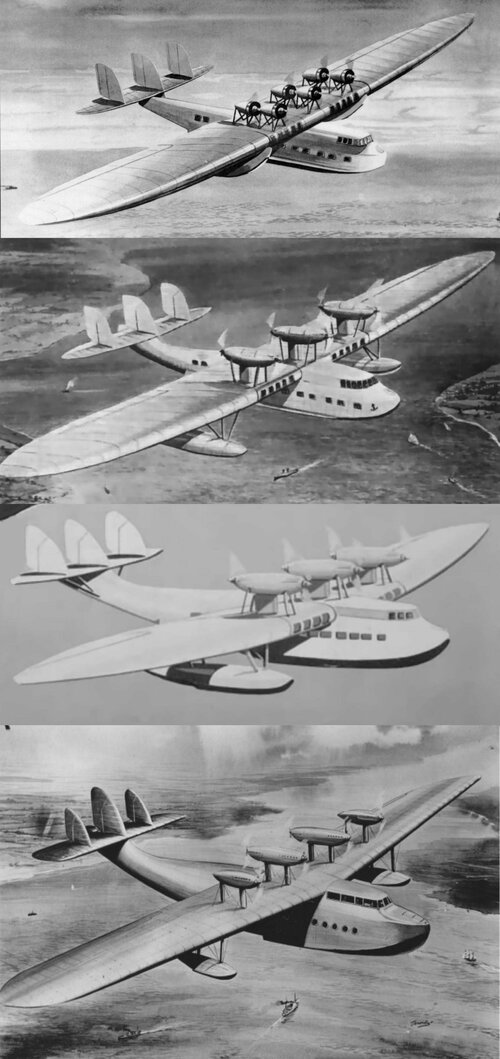You are using an out of date browser. It may not display this or other websites correctly.
You should upgrade or use an alternative browser.
You should upgrade or use an alternative browser.
Vickers Supermarine Type 179 flying boat
- Thread starter Sandi
- Start date
- Joined
- 26 May 2006
- Messages
- 33,556
- Reaction score
- 13,664
red admiral
ACCESS: Top Secret
- Joined
- 16 September 2006
- Messages
- 1,621
- Reaction score
- 1,895
This would be the Supermarine Type 179 powered by 6 supercharged Rolls-Royce Buzzards giving 1030hp.
Correct.The original sheme for the Supermarine type 179 'Giant' used 6
Bristol Jupiter engines in tandem rows and had provision
for passenger cabins within the wings.
Supermarine Aircraft since 1914. CF Andrews & EB Morgan- Putnam.
Bristol Jupiter engines in tandem rows and had provision
for passenger cabins within the wings.
Supermarine Aircraft since 1914. CF Andrews & EB Morgan- Putnam.
- Joined
- 1 May 2007
- Messages
- 2,537
- Reaction score
- 1,750
From putnam's 'Supermarine', pp315-9.
Before cancellation, the registration G-ABLE was allocated.
Before cancellation, the registration G-ABLE was allocated.
Attachments
- Joined
- 25 June 2009
- Messages
- 14,137
- Reaction score
- 4,312
From a (fantastic) online presentation on the SARO Princess comes this nice slide.
Attachments
red admiral
ACCESS: Top Secret
- Joined
- 16 September 2006
- Messages
- 1,621
- Reaction score
- 1,895
- Joined
- 26 May 2006
- Messages
- 33,556
- Reaction score
- 13,664
Stargazer2006 said:Great! Just found something myself: an alternate six-engined configuration (Source: Flight, 1953).
The Source;
http://www.secretprojects.co.uk/forum/index.php/topic,3353.msg26890.html#msg26890
- Joined
- 22 April 2012
- Messages
- 2,272
- Reaction score
- 2,044
This seems very close to the Short Sarafand, especially the proposed monoplane version- even down to the power plant (6 x RR Buzzard), was there some sort of official requirement for a civil flying boat in this class?
http://www.secretprojects.co.uk/forum/index.php/topic,10050.0.html
http://www.secretprojects.co.uk/forum/index.php/topic,10050.0.html
- Joined
- 25 June 2009
- Messages
- 14,137
- Reaction score
- 4,312
hesham said:
No hesham, the source was as I said. I wasn't aware of your topic.
- Joined
- 6 November 2010
- Messages
- 4,634
- Reaction score
- 4,114
The short answer to that: yes....was there some sort of official requirement for a civil flying boat in this class?
A slightly longer answer: according to Bill Gunston in 'Giants of the sky', Oswald Short saw the Do X and thought his company could make an aircraft at two-thirds of the weight with comparable load/range performance. Next, he convinced the government to pay for such an aircraft. Specification R.6/28, which asked for a large reconnaissance aircraft, was written around what was to become the Short Sarafand. The specification was issued to other manufacturers as well, one of them being Supermarine, who designed their type 179. Short received a contract for a reconnaissance aircraft, Supermarine received a contract for a passenger aircraft. Short built and flew one S.14 Sarafand. Supermarine never finished their single type 179; it was cancelled before completion.
- Joined
- 22 April 2012
- Messages
- 2,272
- Reaction score
- 2,044
Thanks Arjen, that also explains why Shorts never even started a monoplane Sarafand.
- Joined
- 19 October 2012
- Messages
- 1,951
- Reaction score
- 1,838
Please allow me to clarify the story regarding the Type 179.
Supermarine drew up a six-engine (probably RR Buzzard) monoplane, Type D in Supermarine's old project naming system, to spec. R.6/28 but this was not ordered by the Air Ministry.
The design was enlarged and modified as a civil flying boat, Type 179, powered by six Bristol Jupiters (see posts #5 and #6). One example was ordered by the Ministry to spec 20/28, but with the engines changed back to RR Buzzards (see posts #2 and #9).
The aircraft was then redesigned completely in 1930-1931; most noticeably the elliptical wing was dropped in favour of straight-tapered and eventually the three twin-engine nacelles became two twin-engine and two single engine (see posts #6 and #8)
Supermarine drew up a six-engine (probably RR Buzzard) monoplane, Type D in Supermarine's old project naming system, to spec. R.6/28 but this was not ordered by the Air Ministry.
The design was enlarged and modified as a civil flying boat, Type 179, powered by six Bristol Jupiters (see posts #5 and #6). One example was ordered by the Ministry to spec 20/28, but with the engines changed back to RR Buzzards (see posts #2 and #9).
The aircraft was then redesigned completely in 1930-1931; most noticeably the elliptical wing was dropped in favour of straight-tapered and eventually the three twin-engine nacelles became two twin-engine and two single engine (see posts #6 and #8)
- Joined
- 25 June 2009
- Messages
- 14,137
- Reaction score
- 4,312
Thanks a lot Schneiderman for these most valuable explanations.
It has often been said that Supermarine pioneered the elliptical wing design with the Spitfire, and though somewhat exaggerated, this proves the elliptical wing truly was on the company's drawing boards from an early stage.
It has often been said that Supermarine pioneered the elliptical wing design with the Spitfire, and though somewhat exaggerated, this proves the elliptical wing truly was on the company's drawing boards from an early stage.
- Joined
- 19 October 2012
- Messages
- 1,951
- Reaction score
- 1,838
Its surprising how many aircraft were drawn with elliptical wings in the early stages of design only for this to be dropped in favour of a simpler style later. The lift/drag benefits were not always worth the additional construction costs.
- Joined
- 19 October 2012
- Messages
- 1,951
- Reaction score
- 1,838
One other reason for not placing the engines on the leading edge was that this was utilised as a condenser for the evaporative cooling system. A further would be that three engines each side places the outer-engines a long way out.
The market for very large flying boats at this point was essentially zero. There was no production order for the Short Sarafand and Dornier's DoX, 3 built, never entered commercial service.
The market for very large flying boats at this point was essentially zero. There was no production order for the Short Sarafand and Dornier's DoX, 3 built, never entered commercial service.
Bazinga
I really should change my personal text
- Joined
- 14 December 2012
- Messages
- 272
- Reaction score
- 374
- Joined
- 19 October 2012
- Messages
- 1,951
- Reaction score
- 1,838
Similar threads
-
Very large Wibault flying boat project - 1930-1931
- Started by Schneiderman
- Replies: 19
-
-
JKoolhoven's flying boat projects
- Started by joncarrfarrelly
- Replies: 21
-
Late 1930s and/or WWII fighter flying boats?
- Started by cluttonfred
- Replies: 54
-


















